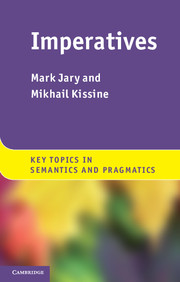Book contents
- Frontmatter
- Contents
- Acknowledgements
- List of abbreviations and notation
- Introduction
- Part I The data
- Part II The theories
- 4 The imperative is directive force
- 5 Declarative-like semantics for imperatives
- 6 The imperative as a distinct semantic type
- An opinionated conclusion
- Appendix A Possible worlds and semantics
- Appendix B Modality in possible-word semantics
- Appendix C Stalnaker’s common-ground model of assertion
- Glossary
- References
- Index
6 - The imperative as a distinct semantic type
Published online by Cambridge University Press: 05 July 2014
- Frontmatter
- Contents
- Acknowledgements
- List of abbreviations and notation
- Introduction
- Part I The data
- Part II The theories
- 4 The imperative is directive force
- 5 Declarative-like semantics for imperatives
- 6 The imperative as a distinct semantic type
- An opinionated conclusion
- Appendix A Possible worlds and semantics
- Appendix B Modality in possible-word semantics
- Appendix C Stalnaker’s common-ground model of assertion
- Glossary
- References
- Index
Summary
In the previous two chapters, we looked at two general approaches to the semantics of the imperative mood. The theories discussed in Chapter 4 either treat the imperative as encoding directive force or identify directive force with the imperative mood. Those discussed in Chapter 5, by contrast, attempt to explain the imperative by positing a relationship with the declarative mood. The theories discussed in this chapter take a different approach in that they neither posit a direct link between directive force and the imperative, nor seek to explain it in terms of another sentence type, such as the declarative. Rather, they treat the imperative as a distinct semantic type, its relationship with directive force constrained by what it encodes, but ultimately mediated by pragmatic considerations.
The theories in question can be grouped according to how integrated they are with a pragmatic theory. The first group have little to say about specific pragmatic mechanisms: they recognise that a pragmatic theory is needed to move from the semantics they propose for the imperative to directive force, but they make no claims about the details of the kind of theory required. Those in the second group, by contrast, offer accounts of the imperative that are elements of ambitious theories of linguistic communication. These aim to integrate imperatives within models of how linguistic communication is achieved. Both pragmatic theories we will discuss – Bach and Harnish (1979) and Wilson and Sperber (1988) – abide by the post-Gricean view that the identification of speaker meaning relies heavily on hearer inference. Consequently, they analyse mood in terms of the contribution it makes to the inferential side of utterance interpretation. However, let us begin by looking at the first group, i.e. those who make no specific claims about the pragmatic processes that, as they acknowledge, are required to complement the semantics they propose. In this group we place Huntley (1984), Davies (1986) and – somewhat more hesitantly – Portner (2009).
- Type
- Chapter
- Information
- Imperatives , pp. 258 - 291Publisher: Cambridge University PressPrint publication year: 2014

